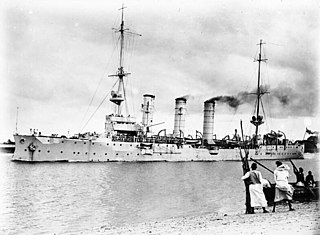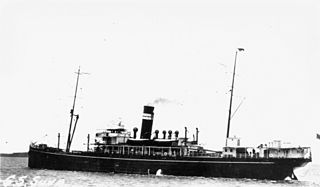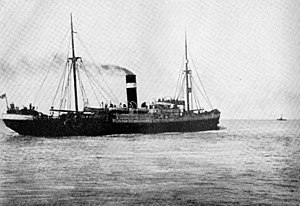
An armed merchantman is a merchant ship equipped with guns, usually for defensive purposes, either by design or after the fact. In the days of sail, piracy and privateers, many merchantmen would be routinely armed, especially those engaging in long distance and high value trade.

SMS Königsberg was the lead ship of her class of light cruisers built by the German Kaiserliche Marine. Named after Königsberg, the capital of East Prussia, she was laid down in January 1905, launched in December of that year and completed by June 1906. Her class included three other ships: Stettin, Stuttgart, and Nürnberg. Königsberg was armed with a main battery of ten 10.5-centimeter (4.1 in) guns and had a top speed of 24.1 knots.

Orion (HSK-1) was an auxiliary cruiser of Nazi Germany's Kriegsmarine which operated as a merchant raider in World War II. Blohm & Voss built her in Hamburg in 1930–31 as the cargo ship Kurmark. The navy requisitioned her at the start of World War II, had her converted into the auxiliary cruiser Orion, and commissioned her on 9 December 1939. Known to the Kriegsmarine as Schiff 36, her Royal Navy designation was Raider A. She was named after the constellation Orion.

SMS Breslau was a Magdeburg-class cruiser of the Imperial German Navy, built in the early 1910s and named after the Prussian city of Breslau. Following her commissioning, Breslau and the battlecruiser Goeben were assigned to the Mittelmeerdivision in response to the Balkan Wars. After evading British warships in the Mediterranean to reach Constantinople, Breslau and Goeben were transferred to the Ottoman Empire in August 1914, to entice the Ottomans to join the Central Powers in World War I. The two ships, along with several other Ottoman vessels, raided Russian ports in October 1914, prompting a Russian declaration of war. The ships were renamed Midilli and Yavûz Sultân Selîm, respectively, and saw extensive service with the Ottoman fleet, primarily in the Black Sea against the Russian Black Sea Fleet.

Stier was an auxiliary cruiser of Nazi Germany's Kriegsmarine during World War II. Her Kriegsmarine designation was Schiff 23, to the Royal Navy she was Raider J.

SMS Wolf was an armed merchant raider or auxiliary cruiser of the Imperial German Navy in World War I. She was the fourth ship of the Imperial Navy bearing this name, following two gunboats and another auxiliary cruiser that was decommissioned without seeing action.

SMS Karlsruhe was a light cruiser of the Karlsruhe class built by the German Kaiserliche Marine. She had one sister ship, SMS Rostock; the ships were very similar to the previous Magdeburg-class cruisers. The ship was laid down in 1911, launched in November 1912, and completed by January 1914. Armed with twelve 10.5 cm SK L/45 guns, Karlsruhe had a top speed of 28.5 knots, which allowed her to escape from British cruisers during her career.

Novík was a destroyer of the Russian Imperial Navy and Soviet Navy, commissioned in 1913 where she served with the Baltic Fleet during World War I. She joined the Bolsheviks in November 1917 and was renamed Yakov Sverdlov in 1923. She was a training ship when Operation Barbarossa began, but was recalled to active duty the following day. She struck a mine on 28 August 1941 and sank while escorting an evacuation convoy during the Soviet evacuation of Tallinn.
Michel (HSK-9) was an auxiliary cruiser of Nazi Germany's Kriegsmarine that operated as a merchant raider during World War II. Built by Danziger Werft in Danzig 1938/39 as the freighter Bielsko for the Polish Gdynia-America-Line (GAL), she was requisitioned by the Kriegsmarine at the outbreak of World War II and converted into the hospital ship Bonn. In the summer of 1941, she was converted into the auxiliary cruiser Michel, and was commissioned on 7 September 1941. Known as Schiff 28, her Royal Navy designation was Raider H. She was the last operative German raider of World War II.

SMS Möwe was a merchant raider of the Imperial German Navy which operated against Allied shipping during World War I.

The Brummer class consisted of two light mine-laying cruisers built for the Imperial German Navy in World War I: SMS Brummer and SMS Bremse. When the war broke out, the Germans had only two older mine-laying cruisers. Although most German cruisers were fitted for mine-laying, a need for fast specialized ships existed. The Imperial Russian Navy had ordered a set of steam turbines for the Borodino-class battlecruiser Navarin from the AG Vulcan shipyard in Stettin. This machinery was confiscated on the outbreak of war and used for these ships. Both vessels were built by AG Vulcan.

SS Arabic, originally built as Berlin, was a passenger steamship launched on 7 November 1908 which was built by the A.G. Weser shipbuilding company in Germany. Her gross register tonnage was advertised at 16,786 tons. She made her maiden voyage on 1 May 1909 from New York to Genoa and Bremerhaven. In September 1914 she became an auxiliary cruiser with the Imperial German Navy as a minelayer.

SS Prinz Eitel Friedrich was a German passenger liner which saw service in the First World War as an auxiliary cruiser of the Imperial German Navy. Though largely overlooked, Prinz Eitel Friedrich was, after SS Kronprinz Wilhelm, the most successful of Germany’s first wave of auxiliary cruisers. She was able to remain at large for seven months, from August 1914 to March 1915, and sank 11 ships, for a total tonnage of 33,000 GRT.

The U-boat Campaign from 1914 to 1918 was the World War I naval campaign fought by German U-boats against the trade routes of the Allies. It took place largely in the seas around the British Isles and in the Mediterranean. The German Empire relied on imports for food and domestic food production and the United Kingdom relied heavily on imports to feed its population, and both required raw materials to supply their war industry; the powers aimed, therefore, to blockade one another. The British had the Royal Navy which was superior in numbers and could operate on most of the world's oceans because of the British Empire, whereas the Imperial German Navy surface fleet was mainly restricted to the German Bight, and used commerce raiders and unrestricted submarine warfare to operate elsewhere.

The action of 29 February 1916 was a naval engagement fought during the First World War between the United Kingdom and the German Empire. SMS Greif, a German commerce raider, broke out into the North Sea and Admiral Sir John Jellicoe dispatched Royal Navy warships to intercept the raider. Four British vessels intercepted the commerce raider Greif. The armed merchant cruiser RMS Alcantara and Greif fought a brief engagement before British reinforcements arrived when both were severely damaged, both being sunk.

SMS Leopard was an auxiliary cruiser of the Imperial German Navy intended for use as a commerce raider. She was intercepted attempting to break out into the Atlantic and was sunk with all hands in a fierce gun battle with British warships.

An armed boarding steamer was a merchantman that the British Royal Navy converted to a warship during the First World War. AB steamers or vessels had the role of enforcing wartime blockades by intercepting and boarding foreign vessels. The boarding party would inspect the foreign ship to determine whether to detain the ship and send it into port or permit it to go on its way.

SMS Nürnberg, named after the Bavarian city of Nuremberg, was a Königsberg-class light cruiser built for the German Imperial Navy. Her sisters included Königsberg, Stettin, and Stuttgart. She was built by the Imperial Dockyard in Kiel, laid down in early 1906 and launched in August of that year. She was completed in April 1908. Nürnberg was armed with ten 4.1-inch (100 mm) guns, eight 5.2 cm (2.0 in) SK L/55 guns, and two submerged torpedo tubes. Her top speed was 23.4 knots.

The German commerce raiders of World War I were surface vessels used by the Imperial German Navy for its Handelskrieg, a campaign against Allied seaborne trade. The ships comprised warships, principally cruisers, stationed in the German colonial empire before the war began, express liners commissioned as auxiliary cruisers and later, freighters outfitted as merchant raiders. These vessels had a number of successes and had a significant effect on Allied naval strategy, particularly in the early months of the war.

SS Cap Polonio was a German 20,576 GRT ocean liner that was launched in 1914 and scrapped in 1935. She worked the Hamburg Südamerikanische Dampfschifffahrtsgesellschaft route between Hamburg in Germany and Buenos Aires in Argentina. She was named after Cabo Polonio in Uruguay.



















